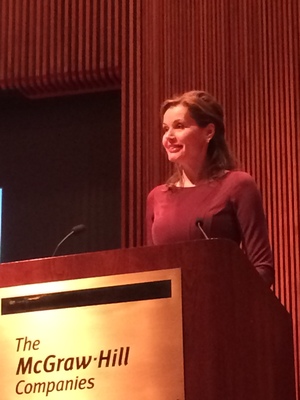It's a pleasure to feature a research/industry collaboration that is having measurably positive effect. The Geena Davis Institute on Gender in Media (GDIGM) has a long-standing relationship with Dr. Stacy Smith's laboratory at the USC Annenberg School for Communication and Journalism.
Smith has conducted more than two dozen studies on gender and media. With the findings, she, Davis and GDIGM CEO Madeline DiNonno have forged a unique and positive strategy for engaging industry leaders.
The most recent research -- debuting this week at GDIGM-sponsored forums in New York, Washington and Los Angeles -- is an international analysis of movie characters in 11 countries' recent domestic films (Australia, Brazil, China, France, Germany, India, Japan, Russia, South Korea, the United Kingdom and the US). The study covers 120 films -- 10 per country, with an extra category for US/UK co-productions -- that were rated each country's equivalent of G, PG or PG-13.
To be honest, the results are pretty bleak. A female in film is more likely to be royalty or a galactic ruler than a political leader (of the 12 found across 120 films in the study, three were Margaret Thatcher).
Worldwide, across about 5,800 speaking or named characters, roughly 69 percent were male and 31 percent female. Fewer than a quarter of the films had a female lead. These numbers have changed little in the past 50 years: Davis notes that at the current rate of change, parity will be achieved in "just 700 years" and says "we are working hard to cut that in half."
Some countries do better, some worse. Of particular note, UK-only films are far more equitable than US/UK co-productions.
In a previous study, GDIGM found that crowd scenes average about 17 percent female. Davis has a theory that writers, directors and animators think women don't "gather"; presumably, she suggests, "they have better things to do."
It's not just ratios. Females are vastly more often the subject of references to weight or beauty, shown in revealing clothing or in some state of nudity. Distressingly, teen females are equally sexualized as those age 20-39. (At the risk of employing a double standard, it's nearly as sad that older women lose virtually all sexuality.)
Women are vastly under-represented in professional roles. In no country were they shown as participating in the workforce at a percentage equal to real life. Beyond the political realm mentioned above, women with "clout" are in short supply in filmed portrayals of business, law, academia, entertainment and religion. They are shortchanged, as well, in STEM professions despite -- at least in some countries -concerted efforts to foster progress among girls and women in science.
A key element in the path to equality is increasing representation of women behind the camera. To the extent gender could be identified, women constituted only 7 percent of directors, just under 20 percent of writers, and about 23 percent of producers in the international study.
Some might take in these numbers and start to "name and shame" studios, channels or producers. GDIGM has taken a different, constructive approach, focusing on simple solutions that don't intrude on creative freedom, cost money or time.
Geena Davis' stature (pun fully intended) in the industry gets her in the door to meet with senior executives; they know she's not a basher and understands their business.
Once there, she asks questions as simple as "what if...," "what do you think..." and "what would it take..." (she's even done this on set). Usually, the answer is "not much." In 2010, after GDIGM's initial studies analyzing gender balance in movies and TV, Stacy Smith asked studio leaders how difficult it would be to achieve parity in children's and family films. Half indicated that it would be "not at all" difficult - the talent was there and they had some flexibility in casting, depending on stories' needs.
The Institute had simple ideas for writers, too; as basic as altering a script, from "a crowd gathers" to "a crowd gathers; half are female."
It works. In a recent survey of those GDIGM had briefed, 68 percent said they had used the Institute's research to influence two or more projects; 41 percent said three or more. The most frequent changes were to "aspirations or occupations" of female characters, followed by altered dialogue.
GDIGM's motto has been "if she can see it, she can be it." At present, girls still need corrective lenses to see their true potential, but the Institute remains optimistic. In an interview with USA Today, Davis said: "Art doesn't have to imitate life. We can turn it around so life will imitate art."
Have you asked a "what would it take" question today?
Full disclosure: I'm a longtime member of the GDIGM "Ambassador Council and was an Honorary Committee member for the recent New York forum. I come by my passion for gender equity in children's media honestly. I was well trained by a strong mother (and a feminist father) and three strong older sisters, and further shaped by a strong wife and two strong daughters. My very first foray into children and media was a paper on sexism in children's literature that I wrote as a high school junior.
This article first appeared in Kidscreen on September 25, 2014.

